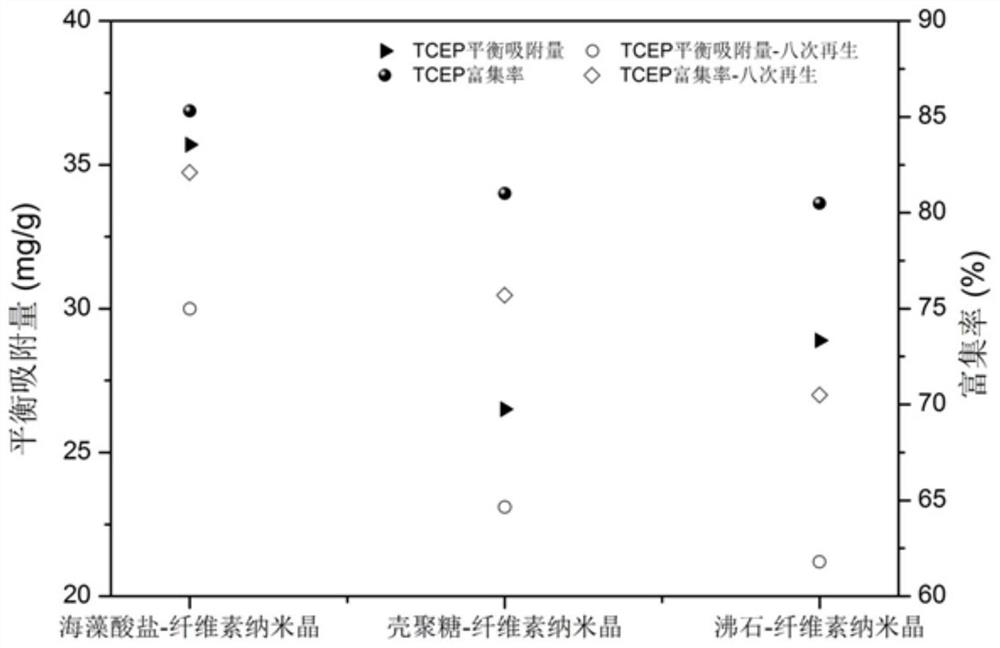Cellulose nanocrystalline loaded sodium alginate adsorbent and application thereof to enrichment of organic phosphorus in wastewater
A technology of sodium alginate and nanocrystals, applied in the field of environmental engineering, can solve the problems of increasing the difficulty and cost of printing and dyeing wastewater treatment plants, high stability, and difficult to remove
- Summary
- Abstract
- Description
- Claims
- Application Information
AI Technical Summary
Problems solved by technology
Method used
Image
Examples
Embodiment 1
[0049] Example 1: Dehydration and drying of papermaking deinking sludge
[0050] Obtain 10L of papermaking deinking sludge mixed solution from the deinking wastewater treatment process section of the papermaking wastewater treatment site (a paper mill in Jiaxing), take out 500mL of the muddy water mixed solution (set 6 parallel samples) under the premise of uniform stirring, and use it after centrifugation Phosphate buffer with a pH of 7.0 was repeatedly diluted 3 times, and finally the volume was adjusted to 500 mL. Three groups of parallel samples were taken out, and after suction filtration, the sludge samples retained on the filter membrane were placed in an oven and dried at 105°C for 4 hours, and then the dry weight of the papermaking deinking sludge was calculated. Take another 3 groups of parallel samples, and add 5% of the sludge dry weight AlCl to the 500mL mud-water mixture successively. 3 and slaked lime which is 20% of the dry weight of the sludge, after 2 minute...
Embodiment 2
[0051] Example 2: Oxidation of papermaking deinking drying sludge and separation of cellulose nanocrystals
[0052] Select the crushed papermaking deinking and drying sludge in the parallel sample, rinse the crushed sludge with a phosphate buffer solution with a pH of 7.0, make the volume of the mixed solution reach 100ml, and keep stirring at a speed of 150r / min , add 0.2mmol of 2,2,6,6-tetramethylpiperidinium oxide radical (TEPMO) 80mg and 5.0mmol of NaBr 80mg in turn, after TEPMO and NaBr are completely dissolved, slowly add 10.0mmo / L of NaClO solution until the pH of the reaction system does not change, then stop the reaction with a slight excess of absolute ethanol, and finally obtain cellulose nanocrystals through microwave separation and centrifugal precipitation.
Embodiment 3
[0053] Embodiment 3: the establishment of alginate-cellulose nanocrystal system
[0054] Under the slightly acidic condition provided by acetic acid, put 2g of sodium alginate into 100mL of acetic acid solution (pH=4.5), slowly add 50mL of dehydration filtrate of papermaking deinking sludge, and mix sodium alginate and dehydration filtrate under stirring condition The calcium ions are fully mixed and uniformly dispersed to form an alginate-acetic acid mixture. Dissolve 0.2 g of the prepared cellulose nanocrystals in 50 mL of acetic acid solution (pH=4.5), and slowly add them into the alginate-acetic acid mixture after stirring and mixing, and then the obtained alginate-cellulose nanocrystals The crystal mixture was dried in an oven at low temperature (75° C.) for 24 hours, and the moisture was balanced for later use.
PUM
| Property | Measurement | Unit |
|---|---|---|
| length | aaaaa | aaaaa |
| diameter | aaaaa | aaaaa |
| diameter | aaaaa | aaaaa |
Abstract
Description
Claims
Application Information
 Login to View More
Login to View More - R&D
- Intellectual Property
- Life Sciences
- Materials
- Tech Scout
- Unparalleled Data Quality
- Higher Quality Content
- 60% Fewer Hallucinations
Browse by: Latest US Patents, China's latest patents, Technical Efficacy Thesaurus, Application Domain, Technology Topic, Popular Technical Reports.
© 2025 PatSnap. All rights reserved.Legal|Privacy policy|Modern Slavery Act Transparency Statement|Sitemap|About US| Contact US: help@patsnap.com



